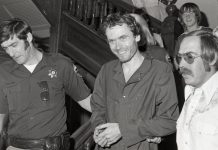Jordon Commons in Sandy, Utah, was bustling with excitement Wednesday evening, March 30th. Surrounded by friends, fans, and the families of the “Saturday’s Warrior” cast and crew, LDS.net saw firsthand the influence this Mormon-culture-classic has had on generations.
But before the crowd of thousands swooped in, we had the privilege of gathering with select LDS bloggers and vloggers for a private Q&A session with the makers of “Saturday’s Warrior.”
We’re delighted to share what we learned with our readers. So, before you go see the movie (and you really, really should), here’s an exclusive look into the making of “Saturday’s Warrior.”
1. This was Kenny Holland’s first time acting.
You’d never guess it, but it’s true. Kenny Holland, who plays Jimmy Flinders in the film, considers himself to be a musician, primarily. When we asked him what his biggest challenge on set was, he answered, “The fact that I had never acted before, it was a completely new medium of art for me. I’m a musician. Music is in my blood, it’s my passion. So, to be able to jump into a whole new style of art was really excitingly difficult. I would love to do more of it.”
Lex de Azevedo, who of course, wrote the music for “Saturday’s Warrior,” stated, “We saw him, and he is Jimmy Flinders.”
Michael Buster, the director, added, “At first I was thinking, my gosh, the lead in my film is someone who hasn’t done this before! But I sat him down, and our casting process consisted of, essentially, [the question] can you be yourself? Let me help you figure out how to relax enough to be you while you say our words. He was so good at taking direction that we really felt like we had something. He just got better and better as the film went on.”
Kenny stated that his favorite scene to film was the song “Line upon Line,” a duet between Jimmy and Pam Flinders.
2. This 2016 film is still set in the 70’s.
Both Azevedo and Buster wanted this film to resonate with modern audiences. You might be wondering: then why set the new adaptation in the 70’s?
According to Azevedo, the answer is really quite simple. “You don’t have to have been alive to enjoy a WWII film, or WWI, or Prohibition. A good story is timeless, and ‘Saturday’s Warrior’ was written in 1973. The music is organic to the 70’s, the plot is organic to the 70’s.”
In order to pull this off, the crew accumulated authentic 70’s furniture (which, they joked, they now need to get rid of), and talented costume designer Jennifer “Iffer” Mitchell worked long hours as the film’s key costumer. A few of the costumes were on display at the premiere—and you’ll certainly see them in the movie!
3. The characters are much more complex.
In the hopes of connecting with their modern-day audience, the writers took a significant amount of time fleshing out the original characters, making them much more “gray” and less “black and white”—one of the film’s strongest points, we noted.
Terri Flinders, for example, brilliantly played by Alison Akin Clark, loves her family, but it’s clear that she’s also given up dreams of her own in order to have one.
Even the ever-faithful Pam Flinders, played by Anna Daines, has her moments of faith-trying hardship. Buster stated, “Pam represented pure faith in the original story. She had some struggles going on in her life, but she was always faithful. As we were approaching the story, we thought, I think that she does exude faith, but I think she struggles. And I never saw that before, in any versions I’ve seen. We added an element to her where she expresses faith to her brother because she wants her brother to be a part of what she loves so much, but her life is hard.”
Anna Daines added, “Everyone has something in their life that makes them have to decide how to live.”
4. Every drawing you see done by character Tod Richards was created by the actor, Mason Davis.
In addition to taking on vegetarianism for a time, Mason Davis connected with his character by revisiting his passion for art.
He said, “I did a lot of research on the time period to find specific things about Tod that would relate, such as being a vegetarian. When I got the breakdown of the character, I knew he was an artist. I am an artist, and in both auditions I had my sketchbook with me in my bag.”
“He even sketched a picture of my headshot!” Buster added.
Davis continued, “I did over fifty sketches and paintings for this movie. Every art piece you see in the film, I did. I like to dedicate and challenge myself as an actor.”
5. New musical numbers were created for the 2016 film.
Azevedo stated that from the beginning, he knew there were new elements to this adaptation that had to be there. For example, the movie couldn’t start out with the song “Saturday’s Warrior,” because, in his words, it was “too ponderous, too significant.” He wrote a new song specifically for Alex Boyé, who, take it from us, knocked the number out of the ball park. According to Azevedo, the aim of the new intro was to communicate that “we’re just having a great time, here. We’re not taking ourselves so seriously.”
Another number, written for Davis, was created to broaden his character. Azevedo commented on Davis’ character, “He’s struggling, he’s an artist, and he’s been searching for truth his whole life. He grew up in a trailer with an abusive father and an alcoholic mother. That’s who he is. He’s wondering, ‘there’s got to be more to life than just what I see.’ That became the central message of the film.”
Everyone on the panel advised audiences to watch for another special number, which will be featured during the final credits. We at LDS.net second that advice!
6. While Davis had never seen “Saturday’s Warrior” before, Daines knew the original show by heart.
Davis admits that although he was raised LDS, he’d never heard of “Saturday’s Warrior” before his audition. In fact, after reading the subject headline in his email inbox, “‘Saturday’s Warrior’ Audition,” Davis believed he was going to an audition on Saturday for a film called “Warrior.” This confession got a laugh from the entire room.
Anna Daines said she had the opposite experience. “I grew up watching the 1989 video every Sunday. I had the whole thing memorized, word for word, dance move for dance move. I didn’t re-watch it for the audition, though, because I knew the character was going to be different.
“At call backs,” she continued, “I was asked to sing. I hadn’t prepared a second number, so, I decided to sing ‘Line upon Line.’ My struggle was in working against the huge experience I’d previously had with ‘Saturday’s Warrior,’ and breathing new life into it.”
She and the director worked together to create a back story for Pam that would resonate with audiences both new and returning.
7. The whole project was filmed in San Fransisco and Utah.
One of the crew’s primary goals, according to Buster, was to maintain authenticity throughout the filming process—with the acting, the designing, and yes, even the setting. That meant taking the crew to San Fransisco in the scenes with Jimmy Flinders’ band, Warrior, as well as the scenes with Tod Richards in the park.
Although both Utah and San Francisco present unique filming challenges, we can honestly say (now that we’ve seen the film) that every scene, especially the outdoor shots, turned out spectacularly.
“We wanted to fake things as little as possible,” Buster said. “It helps when the actors aren’t having to deal with so many things, when they can just be the character without having to pretend [everything else].”
8. Alex Boyé was “this close” to portraying an old man in the film.
Alex Boyé is credited as the Heavenly Guide in IMDb, but “guide” is far from being the only thing Boyé does in this film. Those of you who’ve seen some of his YouTube work know him for his big, bold personality, so we asked him: how did you bring your personality to this role?
It turns out the writers were originally talking with Boyé about dressing up as an old man. “We were trying to figure out how old I was supposed to be,” Boyé said. “We were talking about getting me all Ray Charles-ed up with gray hair, wrinkles, all that type of stuff. Then we whittled the role down to just being myself—well, a more chill version.”
Boyé noted that while his co-star, Daines, had no trouble transitioning from the stage to film, Boyé struggled a little more toning down that exuberant energy we know and love him for.
9. Director Michael Buster considers this film a “musical dramedy.”
Although there was no drama on the set, thanks to the pleasant, carefully selected cast members, Buster and Azevedo agree that this film is much more of a drama than a comedy in comparison to the stage production, although the film definitely has its comedic moments.
During the conference Buster stated that because of the characters’ development from the initial story, there are a few darker elements to what you’ll see on screen. However, where the story darkened in places, comedy would certainly follow, “otherwise the story would feel incongruent,” Buster clarified.
10. Anyone who loves the original film/musical shouldn’t be worried.
For all of you die hard “Saturday’s Warrior” fans who might be feeling a little anxious about the new film, here’s what Azedevo and Buster had to say: their hope from the beginning was to change as little about the original story as they had to. Any changes that were made, as Buster stated, were to help the story resonate more profoundly with the audience. “We didn’t want to treat the audience like they couldn’t understand what they were seeing.”
Daines, herself a life-long “Saturday’s Warrior” fan, added, “Everything that you already loved about the characters is now richer and deeper, more like real people with difficult lives. . . . It will now resonate with a broader audience, rather than just people who loved it before, or just Mormons.”
From its costumes to its characters to its masterfully revisited songs, “Saturday’s Warrior” is an absolute must-see for anyone who wonders if there’s more to life than what we see.





